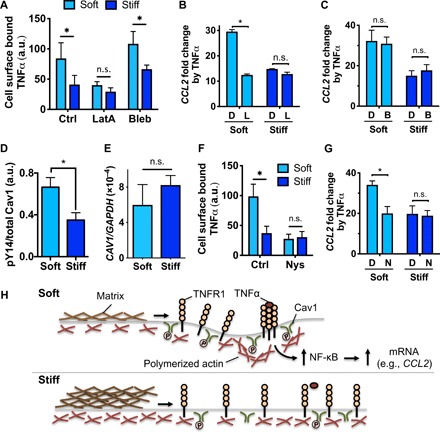Fig. 3. Actin polymerization and lipid rafts mediate responsiveness of MSCs to TNFα in soft matrix.

(A) TNFα binding to MSCs in soft or stiff 3D gels in the presence of DMSO (Ctrl), latrunculin A (LatA, 0.25 μM), or blebbistatin (Bleb, 10 μM) for 3 hours. P < 0.05 two-way ANOVA with Sidak’s multiple comparison test, *P < 0.05 (n = 3 experiments). (B) Effects of inhibiting actin polymerization on TNFα-induced CCL2 mRNA expression. MSCs in soft or stiff 3D gels were preincubated with DMSO (“D”) or latrunculin A (“L”) for 1 hour, treated with or without TNFα in the presence of the drugs for 2 hours, followed by washout and incubating in media for 1 day prior to qPCR. (C) Effects of inhibiting myosin-II contractility on TNFα-induced CCL2 protein expression. Gel-encapsulated MSCs were treated with TNFα in the presence of DMSO (“D”) or blebbistatin (“B”) in the same manner as (B). (D) Phosphorylation level of caveolin-1 (Cav1) at Tyr14 in MSCs after 1 day of encapsulation in soft or stiff 3D gels. (E) Gene expression of CAV1 relative to GAPDH measured by qPCR after culturing MSCs in soft or stiff 3D gels for 1 day. (F) TNFα binding to MSCs in soft or stiff 3D gels in the presence of DMSO (Ctrl) or nystatin (Nys, 50 μM) for 2 hours, followed by washout and incubating in media for 1 day prior to qPCR. (G) Effects of inhibiting lipid rafts on TNFα-induced CCL2 mRNA expression in the presence of DMSO (“D”) or nystatin (“N”) in the same manner as (B). For (B) to (G), *P < 0.05, paired t test; n = 3 experiments; and error bars, ±SEM. (H) Model of actin polymerization and lipid rafts in mediating matrix stiffness–dependent binding of TNFα to the cell surface. In soft matrix, lipid rafts mediate redistribution of actin polymerization to facilitate clustering of TNFR1 in response to TNFα. In contrast, stiff matrix impedes this process, thereby impairing TNFR1 clustering and TNFα binding. a.u., arbitrary unit.
